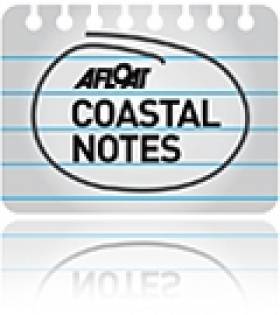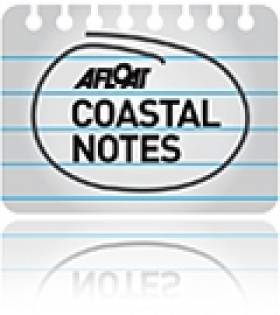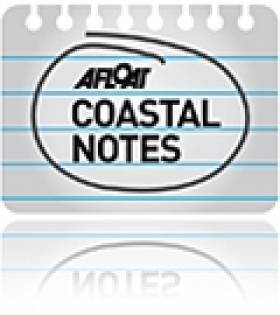Displaying items by tag: Coastal Notes
94% Of Irish Beaches Meet Stricter Bathing Quality Standards
#CoastalNotes - Ireland gets an 'A' for seaside bathing, as 94% of beaches have met the EU's new stricter water quality standards.
And as RTÉ News reports, three out of every four Irish beaches have been rated as 'excellent' on the new scale for levels of microbiological contaminants, which is "twice as strict" as in previous years.
But seven out of 136 bathing places monitored by the Environmental Protection Agency (EPA) in 2014 still failed the test.
Youghal in Cork, Clifden and Ballyloughane in Galway, Rush's south beach in North Co Dublin, Duncannon in Wexford, Ardmore in Waterford and Liliput on Lough Ennell in the Midlands were all rated 'poor', for the most part due to wastewater discharges.
Ten other popular seaside spots – including Trá na mBan in Spiddal and the beaches at Merrion Strand, Loughshinny and Balbriggan's front strand in Co Dublin - were rated as 'sufficient' as they are still prone to periodic pollution episodes, according to The Irish Times.
But there was good news for the denizens of Trá Inis Oirr in Galway Bay, which scored an 'excellent' rating in its first year on the EPA's list.
The Aran Islands beach was added in the same year that nearby Trá gCaorach became a first-time winner in the National Green Coast Awards.
The EPA's Splash website maps out the latest bathing quality ratings for beaches around and throughout Ireland. The agency's report on bathing quality in 2014 can be found HERE.
Skerries Named Among 'Most Beautiful Cities In Europe'
#CoastalNotes - TheJournal.ie might not take the news entirely seriously, but it's true – Skerries has been named among the 10 most beautiful cities in Europe.
The North Co Dublin coastal town and fishing port might only have a population of 10,000, but Eating Europe Food Tours saw fit to include it alongside perennial continental favourites such as Amsterdam and Barcelona.
And TheJournal.ie has collected a few images that show exactly why Skerries is a jewel to be treasured, even if it isn't really a city!
Waves Setting Records Around Irish Coast
#WaveRecord - The waves just keep getting higher off Ireland's coast!
Following our report in January this year that the M3 weather buoy measured the second highest wave off the West Cork coast comes news of an even bigger swell just a few weeks later.
Met Éireann's Columba Creamer informs us of a maximum individual wave height of 21.91 metres recorded on the night of Monday 23 February.
That's more than two metres clear of the previous record set by the MM3 weather buoy in January 2013, and marks the fourth highest wave recorded across Ireland's buoy network.
But there's more, as Monday 26 January saw Ireland's biggest ever wave – a 23.44-metre whopper – recorded by the M4 buoy off Donegal.
Creamer – Met Éireann's port meteorological officer, who quality controls data streams from Ireland's buoy network – says the four Fugro buoys (labelled M2, M3, M4 and M5) measure significant wave height, individual wave height, swell height, wind wave height, period and direction for each wave type.
#OnTheWater - This week's unseasonably fine weather saw thousands flock outside to enjoy the sunshine - and many of them headed to Ireland's finest beaches, some of which were highlighted by JOE.ie.
Among the most beautiful stretches of sand selected by the website include Brittas Bay – a perennial favourite in Dublin and Wicklow alike – as well as Inchydoney in West Cork, surfers' choice Tullan Strand in Bundoran, and the sheltered calm of Keem Beach on Achill Island.
All are recommended for their relaxing potential and arresting views as much as for swimming.
But one place where swimming is definitely not recommended is at Dublin's Docklands, where young people were seen leaping from a quayside roof into the River Liffey yesterday (Friday 10 April).
TheJournal.ie has an image of the group jumping from the roof of a restaurant on North Wall Quay just west of the Samuel Beckett Bridge, flying over the heads of unsuspecting passers-by on the footpath below.
The Irish Coast Guard has reiterated previous warnings "not to engage in this particular type of activity" which amounts to "literally jumping into the unknown".
Dunmore East In Focus In New Video Profile
#CoastalNotes - Online video channel IrishTV has turned its cameras on Dunmore East for the latest edition of Waterford County Matters – going out on the water with the local RNLI lifeboat for a training exercise, discussing seasonal trade with businesses in the popular seaside town and much more besides.
Youghal Boardwalk Rebuilding Works Under Way
#CoastalNotes - Works have begun on replacing the boardwalk in Youghal on the East Cork coast that was destroyed in last year's winter storms, as the Irish Examiner reports.
The original timber-framed 'eco-boardwalk' at Claycastle beach was open less than two years before it collapsed in the face of brutal storm-force winds in January 2014.
It's now being replaced by a stronger steel frame with hardwood panels imported from Cameroon – at a cost of some €220,000 – and is expected to reopen within six weeks, in plenty of time for the busy summer season.
The Irish Examiner has much more on the story HERE.
Coastal News: Connemara 'Disappearing', Landfill Erodes Into Irish Sea, Plastic Pollutes Oceans
#CoastalNotes - Is Connemara at risk of disappearing into the sea? According to one geologist, that's a distinct possibility.
As the Irish Mirror reports, Jonathon Wilkins noticed that the tide was flooding channels in a peat bog near NUI Galway – a tell-tale sign of 'post-glacial rebound'.
That's the process of the land recovering from the weight of glaciers during the Ice Age, and in most cases it means the level of the earth is rising, such as northern parts of the island of Ireland.
But Connemara is one of those that's dropping, and slowing slipping below sea level as the seawater effectively dissolves the bogs and granite bedrock.
Wales-based geological expert Wilkins described what he saw as "very powerful evidence that sea level, to my surprise, is rising in this area, and demonstrably over quite a short time scale."
Disappearing even faster into the sea is an old landfill site in Bray – and it's raised the ire of environmentalists.
According to the Belfast Telegraph, the disused rubbish tip north of the Co Wicklow seaside town continues to lose some of its 200,000 tonnes of refuse into the Irish Sea due to coastal erosion.
And that's despite the problem being identified more than 20 years ago, according to Coastwatch – which says some 200 metres of the face of the landfill site has been exposed by weathering, littering the cliffs below.
The pollution only adds to the 8.8 millions tonnes of plastic that's dumped into the world's oceans every year, according to the journal Science.
The Irish Times reports on these latest findings, which show that one third of this plastic waste is produced by China alone.
#CoastalNotes - The history of Strangford Lough stretching back some 10,000 years is the subject of a 'spiritual motorcycle journey' by local writer Peter Moore, as the News Letter reports.
Moore, a motorbike enthusiast and archaeology graduate, hopes his new book, Valhalla and Fjörd, will inspire others to "further explore the area and enjoy the stories" relating to the "wonderful history in and around" the scenic lough.
“At the start of this journey I was unaware of just how much history there was to uncover around Strangford Lough and the fascinating stories of those that lived here over the past 10,000 years," he says of his project, which he hopes to be the first in a series of books.
Moore's journey took him on his restored Triumph motorcycle via old monastic sites, ruined abbeys and churches and other unmarked settlements around the shores of the Co Down inlet, which takes its name from the Norse for 'strong ford' after its powerful tidal currents.
The News Letter has more on the story HERE.
Video Captures Drone's-Eye View Of Wild Atlantic Way
#CoastalNotes - Via TheJournal.ie, check out this breathtaking video by photographer Peter Cox, who mounted a camera to a remote operated drone to capture stunning coastal vistas on the Wild Atlantic Way.
Using little more than consumer-level tech, Cox was able to film incredible aerial shots of the kind previously only available those with big budgets on expensive helicopter shoots.
But he says his experiments have not been without their crashing failures, including one potentially disastrous moment when an engine tore off his drone at Loop Head.
TheJournal.ie has more on the story HERE.
Coastal Attractions Big Winners At Responsible Tourism Awards
#Tourism - Coastal attractions made up the bulk of the winners at Wednesday night's Irish Responsible Tourism Awards, as Business & Leadership reports.
And Jim Kennedy's Atlantic Sea Kayaking – which took the gold medal for Best Adventure Activity Provider for Responsible Tourism – also took the overall award at the inaugural ceremony hosted at Dublin's Radisson Blu Royal Hotel.
Elsewhere, golds went to the Co Clare's Loop Head Peninsula in Co Clare (for Best Destination for Responsible Tourism) and Dolphin Watch (for Best in a Marine or Coastal Environment).
Completing the trifecta for the Banner County, the Hotel Doolin won gold in the Best Small Hotel or Accommodation for Responsible Tourism category.
Meanwhile, Connemara Wild Escapes - which promotes various activities from walking to angling – was named Best Tour Operator for Responsible Tourism.
Business & Leadership has more on the story HERE.






































































